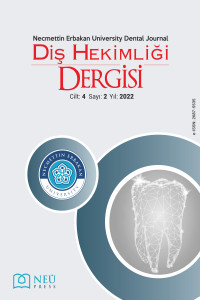Genç Yetişkin Bireylerin Mandibular Çalışan Taraf Hareket Paterni ve Oklüzal Kontaklarının Tespiti
Amaç. Oklüzyon dinamiği zor anlaşılan bir fenomendir. Bu çalışmada lateral mandibular hareketler sırasında oklüzal temaslar ve diş temasları incelenecektir. okluzyon tipi dağılımının tespit edilecektir. Gereç ve Yöntem: Çalışmaya yaşları 20-26 arasında değişen 105 kişi (erkek: 34, kadın: 71) dahil edildi. Seçim kriterleri şu şekildeydi: tüm denekler (i) yirmili yaşlarındaydı; (ii) temporomandibular belirti ve semptom yoktu; (iii) üçüncü azı dişleri dışında tam dişlere sahip; (iv) ortodontik tedavi öyküsü yoktu; ve (v) bir cusp tepesi içeren restorasyonlara sahip değildi. Oklüzal temaslar, artikülasyon kağıdı ile maksimum interkübasyondan 1, 2 ve 3 mm ve maksimum lateral hareket esnasında kaydedildi. Veriler ki-kare testi ve Fischer Exact test ile analiz edildi.(p <0,05) Bulgular Çalışan tarafındaki temas paternlerinin çoğu posterior grup fonksiyon olarak sınıflandırıldı (ort:%57,4). Kanin rehberliği ise nadirdir. (ort: %9,8). Tanımlanmamış diğer temaslar ise önemli bir yer tutmaktadır (ort: %20,2). maksimum lateral hareket konumunda en çok anterior grup rehberliği izlenmiştir. Sonuç: Laterotrüzyonda, deneklerin çoğunun çalışan tarafta posterior grup rehberliği vardı, ancak kanin rehberliği nadirdi. Tanımlanmamış diğer oklüzal temaslar için tanımlayıcı çalışmalar yapılması gerekmektedir.
Anahtar Kelimeler:
mandibular hareketler, çalışan taraf, lateral hareket.
Determination Of Mandibular Working Side Movement Pattern And Occlusal Contacts On Young Adults
___
- 1. Çalıkkocaoğlu S. Dişsiz Hastaların Protetik Tedavisi, 5. Baskı Quintessence Yayıncılık, İstanbul. 2010. Sy:117-120
- 2. Türp JC, Greene C, Strub J. Dental occlusion: a critical reflection on past, present and future concepts. Journal of oral rehabilitation. 2008;35(6):446-53.
- 3. Stuart CE, Stallard H. Principles involved in restoring occlusion to natural teeth. J Prosthet Dent. 1960; 10: 304–13.
- 4. Schuyler CH. Factors of occlusion applicable to restorative dentistry. J Prosthet Dent. 1953; 3: 772–82.
- 5. Schuyler CH. Factors contributing to traumatic occlusion. J Prosthet Dent. 1961; 11: 708–15.
- 7. Heydecke G, Akkad AS, Wolkewitz M, Vogeler M, Türp JC, Strub JR. Patient ratings of chewing ability from a randomised crossover trial: lingualised vs. first premolar/canine-guided occlusion for complete dentures. Gerodontology. 2007; 24: 77–86.
- 8. Parnia F, Yazdani J, Fakour P, Mahboub F, Pakdel SMV. Comparison of the maximum hand-generated torque by professors and postgraduate dental students for tightening the abutment screws of dental implants. J Dent Res Dent Clin Dent Prospects. 2018; 12: 190–5.
- 9. Klineberg I. Influences of temporomandibular articular mechanoreceptors on functional jaw movements. J Oral Rehabil. 1980; 7: 307–17. 10. Halperin GC, Halperin AR, Norling BK. Thickness, strength, and plastic deformation of occlusal registration strips. J Prosthet Dent. 1982 ;48: 575–8.
- 11. Ogawa T, Ogimoto T, Koyano K. Validity of the examination method of occlusal contact pattern relating to mandibular position. J Dent. 2000 Jan;28(1):23-9.
- 12. Ogawa T, Ogimoto T, Koyano K. The relationship between non-working-side occlusal contacts and mandibular position. J Oral Rehabil. 2008; 28: 976–81.
- 13. Singh A, Sangur R, Lakshmana Rao B, Mahajan T. A clinical study to determine the pattern of occlusal contacts in lateral positions and ıts validity in classifying guidance patterns. J Indian Prosthodont Soc. 2013; 13: 101–7.
- 14. Parker S. The use of lasers in fixed prosthodontics. Dent Clin North Am. 2004; 48: 971–98.
- 15. Sreekumar AV, Rupesh PL, Pradeep N. Nature of occlusion during eccentric mandibular movements in young adults. J Contemp Dent Pract. 2012; 13: 612–7.
- 16. The glossary of prosthodontic terms: ninth edition. J Prosthet Dent. 2017; 117: C1-e105,
- 17. Yamada R, Ogawa T, Koyano K. The effect of head posture on direction and stability of mandibular closing movement. J Oral Rehabil. 1999; 26: 511–20.
- 18. Ogawa T, Ogimoto T, Koyano K. Pattern of occlusal contacts in lateral positions: canine protection and group function validity in classifying guidance patterns. J Prosthet Dent. 1998; 80: 67–74.
- 19. Agerberg G, Sandstro¨m R. Frequency of occlusal interferences: A clinical study in teenagers and young adults. J Prosthet Dent. 1988; 59: 212–7.
- 20. Ingervall B, Hähner R, Kessi S. Pattern of tooth contacts in eccentric mandibular positions in young adults. J Prosthet Dent. 1991; 66: 169–76.
- 21. Ogawa T, Koyano K, Suetsugu T. The influence of anterior guidance and condylar guidance on mandibular protrusive movement. J Oral Rehabil. 1997; 24: 303–9.
- 22. Hayasaki H, Okamoto A, Iwase Y, Yamasaki Y, Nakata M. Occlusal contact area of mandibular teeth during lateral excursion. Int J Prosthodont. 2004; 17:72-6.
- Yayın Aralığı: Yılda 3 Sayı
- Başlangıç: 2019
- Yayıncı: Necmettin Erbakan Üniversitesi
Sayıdaki Diğer Makaleler
Genç Yetişkin Bireylerin Mandibular Çalışan Taraf Hareket Paterni ve Oklüzal Kontaklarının Tespiti
Mehmet Esad GÜVEN, Gamze BÜYÜKTURHAN, Emine Nisa ÖZDİL, Vural ÖZTAŞ
Hasan GÜNGÖR, Prof. Dr. Zeynep YEŞİL DUYMUŞ
Nazopalatin Kanal Kisti: Üç Olgu Sunumu
Günay YAPICI YAVUZ, Şeyma BAYAZIT
Ahmet Ertan SOĞANCI, Yasar Bedii GOYENC
Panoramik Radyografide Yumuşak Doku Kalsifikasyon ve Ossifikasyonları
